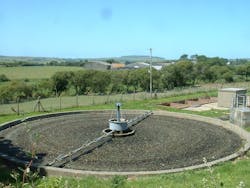The Internet of Sewage
When people debate the impact and benefits of data analytics, the conversation often quickly narrows down to one topic: money. Can data be used to lower costs or increase productivity?
By Michael Kanellos
When people debate the impact and benefits of data analytics, the conversation often quickly narrows down to one topic: money. Can data be used to lower costs or increase productivity?
But, often a third reason starts to bubble up: minimizing regulatory risks. Wind developers, for instance, are required to pay curtailment penalties when they cannot deliver a promised amount of power at a specific time. Mining companies can get their "license to operate" pulled if they exceed thresholds for air pollution or wastewater discharge. Food companies can get penalized for tainted food, of course, but they can also face costly shutdowns if their products are underweight.
In Europe, regulators in many jurisdictions rate utilities on customer satisfaction: if the utility doesn't score well, it can impact the calendar for other projects.
And few, of course, can forget Flint.
Water in many ways will be a leader because of the unusual circumstances the industry must contend with. Think of it. The bulk of the infrastructure is old, spread across huge geographic areas and underground. There are approximately 1.2 million miles of water mains and 1.3 million miles of sewer mains in the U.S. alone. No wonder that we experience more than 240,000 bursts and other incidents a year, according to statistics from Circle of Blue, each one of which can potentially result in calls to the responsible agency.
To upgrade a Netflix data center you generally don't need a backhoe and a work permit.
We're already seeing some interesting examples. In 2017, oyster growers in the Pittwater region of Tasmania were already facing the prospect of weakened harvests because of a POMS (Pacific Oyster Mortality Syndrome) outbreak caused by two storms that overwhelmed the regional combined sewer overflow system. The spill lead to a mandatory 21 day pause in harvesting.
Unfortunately, the shutdown coincided with the Christmas rush, which can account for 20% of oyster sales for the year. To prevent problems like this in the future, TasWater, the local water and wastewater utility, developed analytics that will enable them to pinpoint potential trouble spots. They haven't had an opportunity to test the system in storm conditions yet, but TasWater believes it could have given them up to 13 hours advance notice in the Pittwater storm, enough time to take actions to mitigate the impact.
Meanwhile, San Francisco's Public Utility Commission set up an early warning system that tracks rising water levels at pipelines, cisterns and other locations in real-time. The city's combined storm and wastewater volume can quickly rise from 100 million gallons a day (MGD) to over 200 MGD. If the combined overflows get onto beaches, it can create health hazards and trigger fines. To that end, the system also dispatches biologists to beaches before storm/sewer overflows occur so they can post warnings and prepare to sample.
Similarly, MPWIK in Poland is working on techniques to predict when sewer activity is at its peak so they can reduce their energy bills. Let's say there is a big soccer match: MPWIK will crank up the pumps right before the end of the game to accommodate the tsunami of flushing and then turn them back down so the pipes don't burst from being over-pressurized.
The City of Sudbury in the UK and New Orleans are also implementing data programs for wastewater.
Regulatory mediation doesn't just have to be a zero sum game of minimizing problems. Some insurance companies have started to offer discounts on cyber security policies if policy holders adhere to more stringent operating requirements, like putting in data-diodes to minimize hacking. Another benefit: community relations. If people are given early notice about a problem, they are less likely to become angry, or at least they will be more willing to accept that a utility or organization is doing their best to solve it the next time it happens.
And, if they can fine tune their analytics, maybe there won't have to be a next time.
About the Author: Michael Kanellos is head of corporate communications and technology analyst for OSIsoft. As head of corporate communications and technology analyst at OSIsoft, he tracks how innovation and IoT will impact energy, people and business. He's written for over 20 years for various publications and appeared as a guest on several television news programs. Prior to technology, he also worked as an attorney, a Census Bureau enumerator and a busboy in a pancake house. You can reach him at [email protected].
